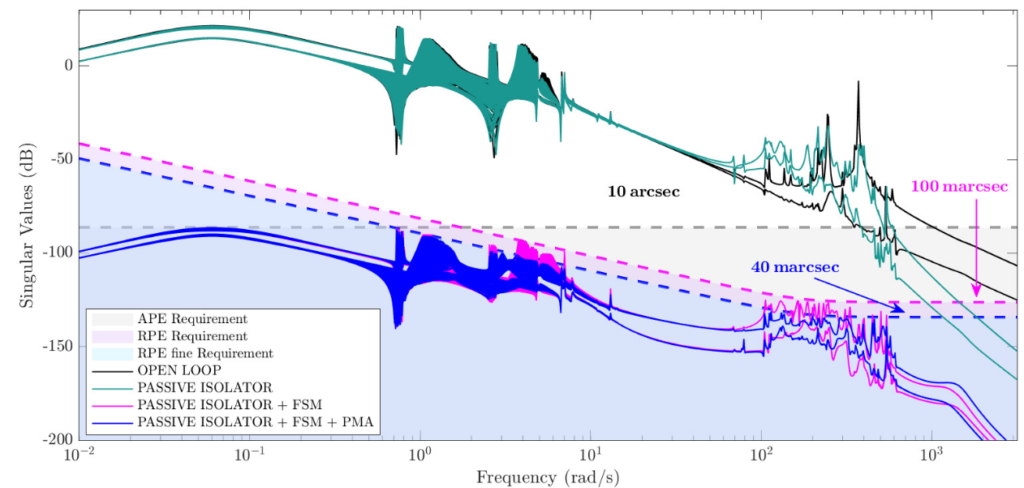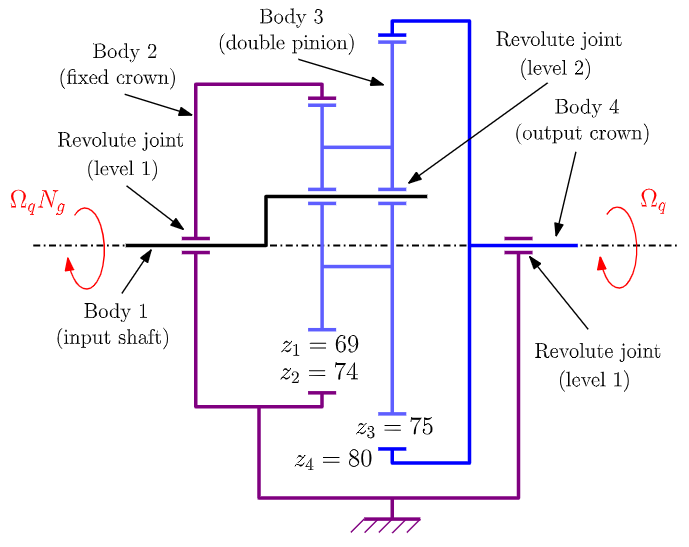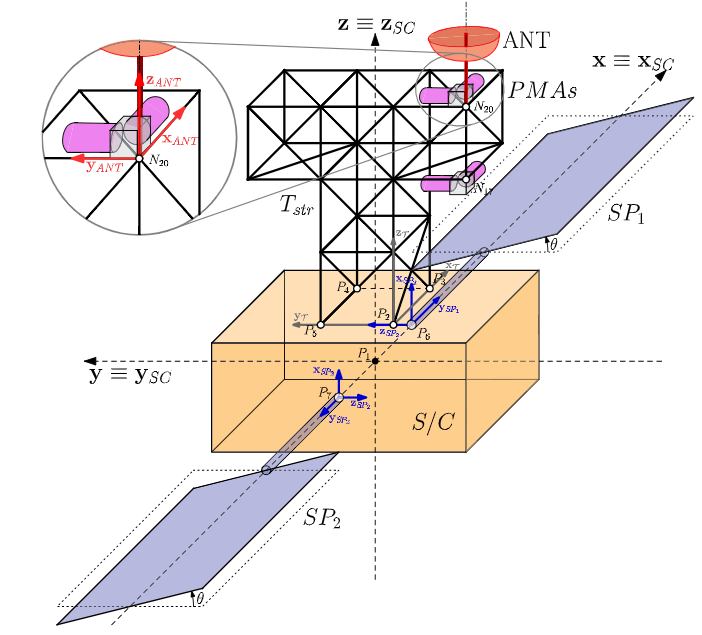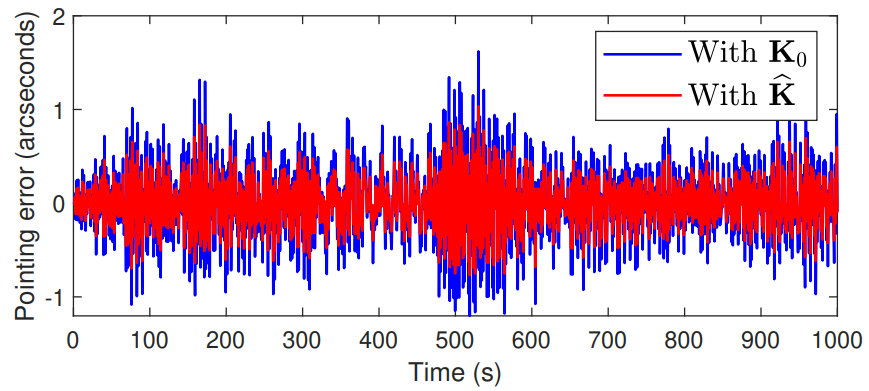Applications
A few challenging applications are presented here to illustrate the capabilities of the SDTlib.
- High-accuracy pointing control
- SADM vibration anomaly
- On-orbit servicing
- Control/structure co-design
- Multibody pendulum-like dynamics

 A generic space observation mission with stringent pointing requirements is considered. The satellite is composed of:
A generic space observation mission with stringent pointing requirements is considered. The satellite is composed of:
- several flexible elements modeled with Nastran: a central body, two solar panels with varying angular configuration, and an optical payload ;
- solar array driving mechanisms (SADM), whose imperfections in the gearbox create microvibrations ;
- reaction wheels, whose imbalances create harmonic vibrations depending on their rotation rate ;
- a passive isolator ; a proof-mass actuator (PMA) ;
- and fast-steering mirrors (FSM).
- analyzing the impact of the various disturbance sources on the pointing error,
- comparing several control architectures,
- optimizing the controllers to push the robust performance to the achievable limits (10 arcsec in low frequencies, down to 40 marcsec in high frequencies).
Sanfedino, F., Thiébaud, G., Alazard, D., Guercio, N., & Deslaef, N. (2022). Advances in fine line-of-sight control for large space flexible structures. Aerospace Science and Technology, 130, 107961.

 An anomalous pointing jitter was observed in the telemetry of an Earth observation satellite of ESA, appearing and disappearing along the orbit. The solar array driving mechanism (SADM) was suspected to be the source of this vibration anomaly.
Thus, an electromagnetic and mechanical model of the SADM mechanism was developped, taking into account the micro-stepping input signal, the detent torque, and the defaults of the gearbox gear teeth. The whole spacecraft was then modeled with the SDTlib.
The resulting model successfully showed how the SADM gearbox disturbance propagated to the line-of-sight, as suspected, by exciting the flexible solar panels depending on their angular configuration along the orbit. A linear-parameter varying (LPV) observer was also scheduled according to this angular configuration to estimate on-board these disturbances.
An anomalous pointing jitter was observed in the telemetry of an Earth observation satellite of ESA, appearing and disappearing along the orbit. The solar array driving mechanism (SADM) was suspected to be the source of this vibration anomaly.
Thus, an electromagnetic and mechanical model of the SADM mechanism was developped, taking into account the micro-stepping input signal, the detent torque, and the defaults of the gearbox gear teeth. The whole spacecraft was then modeled with the SDTlib.
The resulting model successfully showed how the SADM gearbox disturbance propagated to the line-of-sight, as suspected, by exciting the flexible solar panels depending on their angular configuration along the orbit. A linear-parameter varying (LPV) observer was also scheduled according to this angular configuration to estimate on-board these disturbances.
Sanfedino, F., Alazard, D., Preda, V., & Oddenino, D. (2022). Integrated modeling of microvibrations induced by Solar Array Drive Mechanism for worst-case end-to-end analysis and robust disturbance estimation. Mechanical Systems and Signal Processing, 163, 108168.
 The multibody framework is particularly suited to model two satellites, a chaser and a target, connected through a robotic arm and docking mechanism.
The parameterized model is valid for all geometrical configurations of the coupled system, taking into account the large inertia and flexibility changes occuring during the docking operations as well as all parametric uncertainties relative the the flexible elements or local stiffnesses.
This model allows tuning a time-varying controller and analyzing the stability and performance throughout the rendez-vous.
The multibody framework is particularly suited to model two satellites, a chaser and a target, connected through a robotic arm and docking mechanism.
The parameterized model is valid for all geometrical configurations of the coupled system, taking into account the large inertia and flexibility changes occuring during the docking operations as well as all parametric uncertainties relative the the flexible elements or local stiffnesses.
This model allows tuning a time-varying controller and analyzing the stability and performance throughout the rendez-vous.
Rodrigues, R., Preda, V., Sanfedino, F., & Alazard, D. (2022). Modeling, robust control synthesis and worst-case analysis for an on-orbit servicing mission with large flexible spacecraft. Aerospace Science and Technology, 107865.
 A telecom spacecraft was considered as a study case, equipped with a T-shaped truss structure, a high-precision antenna, solar panels, and proof-mass actuators (PMA). The truss structure was modeled in the SDTlib with a sub-structuring approach. While it was also modeled with Nastran for validation, only the SDTlib model was parameterized with a mechanical parameter considered as a decision variable: the length of a unitary cube of the truss structure.
This analytical parameterization allowed performing a control/structure co-design approach, that is, optimizing the mechanical parameter simultaneously with the controller, with the standard robust control tools (routine systune in Matlab). The size and thus the mass of the T-shaped truss were minimized, while still ensuring the pointing precision requirements of the antenna despite the various parametric uncertainties.
A telecom spacecraft was considered as a study case, equipped with a T-shaped truss structure, a high-precision antenna, solar panels, and proof-mass actuators (PMA). The truss structure was modeled in the SDTlib with a sub-structuring approach. While it was also modeled with Nastran for validation, only the SDTlib model was parameterized with a mechanical parameter considered as a decision variable: the length of a unitary cube of the truss structure.
This analytical parameterization allowed performing a control/structure co-design approach, that is, optimizing the mechanical parameter simultaneously with the controller, with the standard robust control tools (routine systune in Matlab). The size and thus the mass of the T-shaped truss were minimized, while still ensuring the pointing precision requirements of the antenna despite the various parametric uncertainties.
Finozzi, A., Sanfedino, F., & Alazard, D. (2022). Parametric sub-structuring models of large space truss structures for structure/control co-design. Mechanical Systems and Signal Processing, 180, 109427.


 Stratospheric balloons are used to carry heavy optical payloads in the near-space environment for high-accuracy astronomy missions. Such systems have multibody dynamics that lead to pendulum-like modes with very low natural damping in the control bandwidth (roughly 0.1 to 10 rad/s for the most impacting modes). These resonances are the main limiting factor to the pointing performance.
The multibody dynamics were modeled using a SDTlib-like framework, and adequately fitted in-flight data of the FIREBall system (joint NASA-CNES mission). The pointing control of an optical instrument on-board the gondola was then optimized for rejection of these flexible modes, to meet a precision of 1 arcsec.
Stratospheric balloons are used to carry heavy optical payloads in the near-space environment for high-accuracy astronomy missions. Such systems have multibody dynamics that lead to pendulum-like modes with very low natural damping in the control bandwidth (roughly 0.1 to 10 rad/s for the most impacting modes). These resonances are the main limiting factor to the pointing performance.
The multibody dynamics were modeled using a SDTlib-like framework, and adequately fitted in-flight data of the FIREBall system (joint NASA-CNES mission). The pointing control of an optical instrument on-board the gondola was then optimized for rejection of these flexible modes, to meet a precision of 1 arcsec.
Kassarian, E., Sanfedino, F., Alazard, D., Montel, J., & Chevrier, C. A. (2023). Modeling of stratospheric balloons and robust line-of-sight pointing control. CEAS Space Journal, 1-18.
